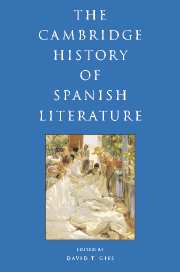Book contents
- Frontmatter
- I INTRODUCTION
- II HISTORY AND CANONICITY
- III THE MEDIEVAL PERIOD
- 2 Medieval Spanish literature in the twenty-first century
- 3 Beginnings
- 4 The poetry of medieval Spain
- 5 Medieval Spanish prose
- 6 The medieval theatre: between scriptura and theatrica
- IV EARLY MODERN SPAIN: RENAISSANCE AND BAROQUE
- V THE ENLIGHTENMENT AND NEOCLASSICISM
- VI THE FORGING OF A NATION: THE NINETEENTH CENTURY
- VII THE MODERN, MODERNISMO, AND THE TURN OF THE CENTURY
- VIII TWENTIETH-CENTURY SPAIN AND THE CIVIL WAR
- IX IN AND OUT OF FRANCO SPAIN
- X POST-FRANCO SPANISH LITERATURE AND FILM
- Bibliography
- Index
- References
6 - The medieval theatre: between scriptura and theatrica
from III - THE MEDIEVAL PERIOD
Published online by Cambridge University Press: 28 March 2008
- Frontmatter
- I INTRODUCTION
- II HISTORY AND CANONICITY
- III THE MEDIEVAL PERIOD
- 2 Medieval Spanish literature in the twenty-first century
- 3 Beginnings
- 4 The poetry of medieval Spain
- 5 Medieval Spanish prose
- 6 The medieval theatre: between scriptura and theatrica
- IV EARLY MODERN SPAIN: RENAISSANCE AND BAROQUE
- V THE ENLIGHTENMENT AND NEOCLASSICISM
- VI THE FORGING OF A NATION: THE NINETEENTH CENTURY
- VII THE MODERN, MODERNISMO, AND THE TURN OF THE CENTURY
- VIII TWENTIETH-CENTURY SPAIN AND THE CIVIL WAR
- IX IN AND OUT OF FRANCO SPAIN
- X POST-FRANCO SPANISH LITERATURE AND FILM
- Bibliography
- Index
- References
Summary
Conventional histories of literature examine the literary qualities of dramatic texts, yet the interrelationship between writing and theatre, between two fundamentally different forms of human creativity, is also a valid concern. Theatre implies a live performance, an essentially evanescent and fluid communal activity; writing embodies a far more stable and enduring personal enterprise. The relationship between writing and performance, between scriptura and theatrica was particularly complex in the Middle Ages when theatrum was broadly defined as a place for sights and sounds, and theatrica embraced a wide range of theatrical activities often lacking a verbal script. Yet almost everything we know about the medieval theatre we owe to medieval writing. Some texts are authentic playscripts incorporated into miscellanies. Few such texts survive, however, because directors normally copied the actors’ roles on scraps of parchment that eventually went astray. Other texts were intentionally reworked in the process of being transcribed, while still other writings contain not the dialogue but a description of the stage props and costumes, financial costs of mounting the show, audience response, or merely the time and place of the performance. The elite nature of scriptura also means that many popular forms of theatrica have often gone unrecorded or appear in negative appraisals.
Colorful church rituals including liturgical dramas have endured better than most medieval performances because they were recorded in medieval service books, although the dramatic scripts did not always survive unscathed. In Catalonia strong ties to Italy and France and the shift already in the eighth century from the Visigothic rite to the Roman–French encouraged the assimilation and development of church drama.
- Type
- Chapter
- Information
- The Cambridge History of Spanish Literature , pp. 115 - 134Publisher: Cambridge University PressPrint publication year: 2005

